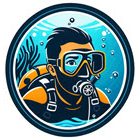Understanding the Corals of Verde Island
The Verde Island Passage, nestled in the heart of the Philippines, is a marine biodiversity hotspot that draws scientists, divers, and nature enthusiasts from around the world. Teeming with life, it is home to an impressive array of species, but among the most significant are the corals. Both hard and soft corals play pivotal roles in maintaining the ecological balance and providing essential services to the ecosystem.
Hard Corals: The Architects of Reefs
Often referred to as stony corals, hard corals are the cornerstone of coral reef ecosystems. They have the unique ability to secrete calcium carbonate, forming solid skeletons over time. This process leads to the creation of the vast reef structures that we see, serving as the basis for a wide range of marine life. The strong, calcified skeletons of hard corals play a dual role, offering both a habitat and a protective shelter for countless marine organisms.
Acropora and Porites are two of the best-known genera of hard corals that can be found flourishing in the waters around Verde Island. These corals are essential for the marine environment because they form the foundational structures of reefs, which subsequently become home to various fish, invertebrates, and other marine creatures. Depending on the species, their growth forms range significantly, from intricately branched designs to large, boulder-like appearances, each contributing uniquely to the reef’s architecture.
The Complexity of Hard Corals
A fascinating aspect of hard corals is their symbiotic relationship with zooxanthellae. These are microscopic algae living within the coral tissues, playing a crucial role in their survival. Through photosynthesis, zooxanthellae provide essential nutrients to the coral polyps, which in turn offer a habitat and access to sunlight for the algae. However, this delicate symbiosis makes hard corals sensitive to various environmental changes. Factors such as rising sea temperatures, increased pollution levels, and ocean acidification pose significant threats to their health and well-being.
Soft Corals: The Flexible Residents
Differing in structure, soft corals are not equipped with the same rigid calcium carbonate skeletons as hard corals. Instead, their bodies are supported by a substance known as gorgonin, an elastic protein that allows them to move gracefully with the ocean currents. This flexibility grants soft corals their distinct, tree-like appearance, adding an enchanting dynamism to ocean landscapes.
Typically found in deeper, less turbulent parts of the ocean, soft corals still manage to thrive within the diverse marine ecosystems around Verde Island. Their varied forms and vibrant colors enrich the aesthetic beauty of coral reefs, while also enhancing their ecological diversity. Despite not contributing to reef building, they are nonetheless invaluable for the habitats and breeding grounds they provide to numerous marine species.
The Role of Soft Corals
The significance of soft corals in maintaining marine ecosystems should not be underestimated. Although they do not form reefs themselves, they provide essential living and breeding spaces for numerous organisms. Their presence contributes to biodiversity, which is crucial for maintaining the health and balance of coral reef systems. By supporting a variety of marine life, soft corals ensure that the ecological web remains intact and resilient.
Conservation Efforts
Both hard and soft corals face myriad challenges in the modern world, driven by human activities such as overfishing, pollution, and the indiscriminate effects of climate change. As coral reefs continue to endure these existential threats, conservation efforts become increasingly vital. Protecting these marine treasures is not just about preserving individual species, but about safeguarding entire ecosystems that are crucial for marine biodiversity.
Sustainable practices, along with the establishment of marine protected areas, represent some of the key strategies being employed to conserve the rich coral habitats of the Verde Island Passage. Such measures not only aim to reduce direct human impact but also foster an environment where corals and their associated ecosystems can recover and thrive.
For those interested in further information on coral conservation or how to contribute to these efforts, online resources can be invaluable. Websites like Coral and Reef Watch offer extensive insights and practical advice on protecting these vital marine habitats.
The Future of Coral Reefs in the Verde Island Passage
Looking ahead, the future of coral reefs in Verde Island hinges on the continued efforts of local and global communities. By raising awareness of the importance of corals and implementing stringent conservation measures, it is possible to mitigate some of the anthropogenic threats they face. Engaging stakeholders, from local fishermen to international policymakers, ensures the inclusion of diverse perspectives and the adoption of comprehensive strategies to preserve these crucial ecosystems.
Education remains another powerful tool in the conservation arsenal. By informing younger generations of the incredible biodiversity housed within coral reefs and the delicate balance required to maintain such environments, a new generation of environmental stewards can be cultivated. This ensures that the passion for protecting these marine ecosystems transcends generational boundaries, fostering a culture of conservation that persists into the future.
In conclusion, the Verde Island Passage and its rich coral ecosystems symbolize both the beauty and fragility of marine life. Hard and soft corals, each with their specific roles and characteristics, contribute immeasurably to the ecosystem’s overall health. Through understanding and championing their conservation, we not only protect a vibrant underwater world but also secure a sustainable future for the countless species, including humans, that rely on these marine ecosystems.

